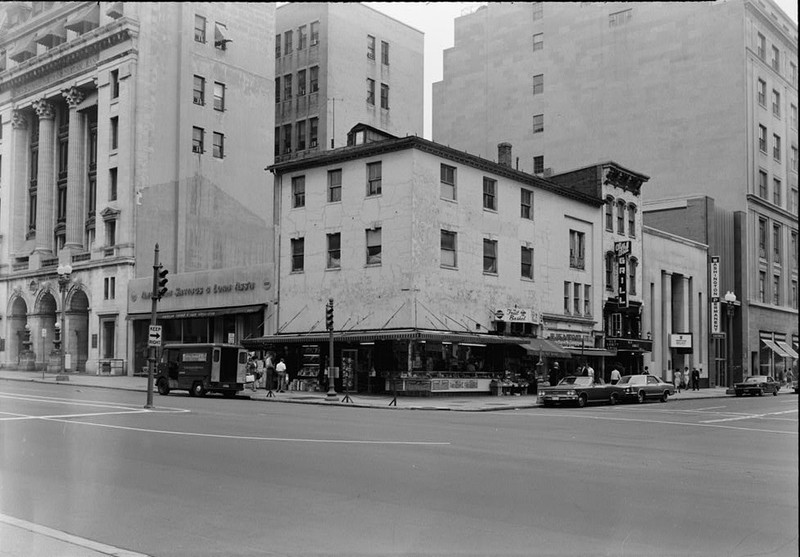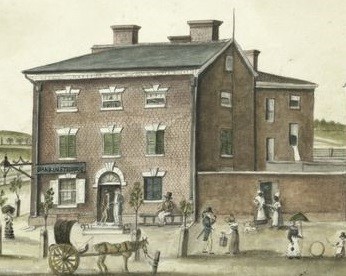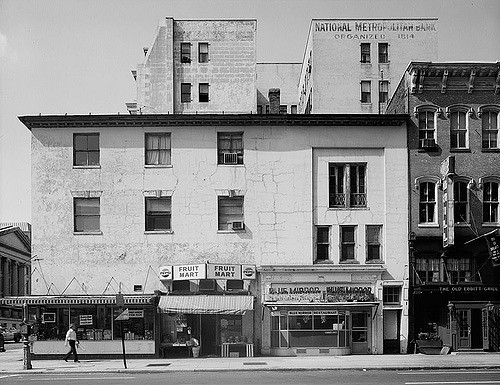Rhodes Tavern
Introduction
Text-to-speech Audio
Images
The tavern building in 1967, courtesy of Historic American Buildings Survey (HABS)

Plaque at the site of the former tavern by John DeFerrari (reproduced under Fair Use)

Drawing of the tavern in 1817 by Anne Margueritte Henriette Hyde de Neuville (public domain)

View of the tavern in 1967, Historic American Buildings Survey (public domain)

Backstory and Context
Text-to-speech Audio
In 1799, David Burnes, a man who owned a considerable amount of land in the newly-developed capitol of Washington, D.C., sold a plot of land to a man by the name of Bennett Fenwick. Fenwick built a property on the land he had procured from Burnes, and it was completed in 1801. Fenwick then leased the building out to William Rhodes, having it serve as a hotel. As the tavern was an early public building in the developing capitol city, it served a number of public, communal purposes, such as serving as a polling house or auction house. Rhodes himself did not remain at the tavern for long, however, as he left the property in 1804. It was leased out again as a hotel called the Indian King from 1805 until 1807, and as a boarding house with additional storefronts from 1807 until 1814.
The Rhodes tavern took a rather different change in use in April of 1814, during which time it was converted to house the Bank of the Metropolis, which it served as until 1836. Additionally, in the midst of the War of 1812, the Rhodes tavern building was occupied on the evening of August 24, 1814, by General Ross and Admiral Cockburn, both British Commanders, as the British set fire to numerous buildings in Washington, D.C., including the White House and the Treasury.
From 1836 on, the Rhodes Tavern building was mainly home to office space for various businesses and firms, aside from a period from 1852 until 1858 when it served as a private bank, and from 1860 until 1899, it was also occupied by stores and spaces for private bankers. The building changed hands numerous times after 1900, and on March 24, 1969, it was placed on the National Register of Historic Places. Despite this appointment to the Register, it was proposed this the Rhodes Tavern and other buildings be torn down in order to make way for a commercial complex. Numerous concerned citizens formed committees and fought against the push to demolish the building, but on September 10, 1984, demolition of the building commenced. In 1999, Joseph Grano, a preservationist who fought to keep the Rhodes Tavern alive, succeeded in getting a plaque to commemorate the building placed on its former site.
Sources
"Battle to Save Rhodes Tavern: A Chronology." Washington Post. September 11, 1984. Accessed July 22, 2016. https://www.washingtonpost.com/archive/politics/1984/09/11/battle-to-save-rhodes-tavern-a-chronology/57764e5c-0afa-46e5-8c1c-7f97b5ba65f2/.
Taylor, Nancy A. “Rhodes’ Tavern.” National Register of Historic Places Inventory/Nomination Form. National Capital Planning Commission, Washington, DC, March 24, 1969. Accessed July 22, 2016. http://focus.nps.gov/pdfhost/docs/NRHP/Text/69000301.pdf.
Tischler, Gary. "1945-2013: Presevationist Joseph Grano, Defender of Rhodes Tavern." The Georgetowner. December 2, 2013. Accessed July 22, 2016. http://www.georgetowner.com/articles/2013/dec/02/1945-2013-presevationist-joseph-grano-defender-rhodes-tavern/.
https://www.loc.gov/pictures/resource/hhh.dc0203.photos.029485p/
http://www.streetsofwashington.com/2009/12/15th-and-f-streets-nw-revisited.html
https://commons.wikimedia.org/wiki/File:Rhodes_tavern_Le_coin_de_F._Street_Washington_vis-%C3%A0-vis_n%C3%B4tre_maison_%C3%A9t%C3%A9_de_1817.jpg
https://www.loc.gov/pictures/item/dc0203.photos.029487p/resource/
